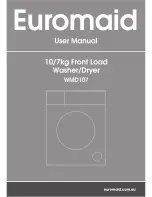
9
GB
USING THE DETERGENT BOTTLE
To enable supply of detergent from the bottle, remove
nozzle of the spray lance according to the arrow on the
Fig. 3a.
The detergent nozzle and tank attaches to the end
of the trigger assembly in the same way as the lance
does. Fill the detergent tank with liquid detergent.
When the trigger is now pressed with the machine run-
ning, detergent will spray out with the water.
RECOMMENDED CLEANING PROCEDURE
Dissolve dirt by applying detergent with the fan jet to
the dry surface. On vertical surfaces, work from the
bottom upwards. Leave the detergent to act for 1 to
2 minutes, but do not allow to dry out. Apply the high
pressure jet, keeping the nozzle at least 30 cm (10 in.)
from the surface, working from the bottom upwards.
Avoid allowing the rinsing water to run on to unwashed
surfaces.
SHUTTING DOWN THE PRESSURE
WASHER
CAUTION!
Never disconnect the high-pres-
sure hose from the machine while the system
is still pressurized.
Follow the correct procedure:
1. Turn off the pressure washer by using the switch on
the machine.
2. Unplug the unit from the power source.
3. Turn off the water supply at the tap.
4. Press the trigger of the gun to depressurize the sys-
tem.
5. Disconnect the supply hose to the machine
6. Wipe all surfaces of the unit with a damp clean
cloth.
7. Engage the safety lock.
TROUBLESHOOTING
1. When switched on, the machine will not start
working.
●
Plug is not well connected or electric socket is
faulty.
- Check plug, socket and fuse.
●
The mains voltage is lower than the minimum re-
quirement for start up.
Check that the mains voltage is adequate.
●
The pump is stuck.
- Refer to after storage instructions. Switch off the
unit and let the motor cool.
●
Thermal safety has tripped.
- Leave the lance open with water comingthrough.
2. Fluctuating pressure
●
Pump sucking air
- Check that hoses and connections are airtight
●
Valves dirty, worn out or stuck. Pump seals worn.
- Clean and replace or refer to dealer.
3. Water leaking from the pump
●
Seals worn out
- Check and replace, or refer to dealer
3. ASSEMBLY
CONNECTING THE HOSE
AND TRIGGER ASSEMBLY
1
2
●
Before connecting any hoses or trigger/ lance
assembly
fi
rst check all connections to ensure they
are free from any blockage.
●
Screw the outlet pressure hose (6) onto the machine
and ensure a good hand tight
fi
t.
●
Connect the spray lance (4) to the trigger (5) by
means of the push in and twist bayonet
fi
tting (
fi
g 2).
Ensure that this connection has been performed
positively and the bayonet has located correctly. En-
sure the hose has no kinks in it.
4. USE
WATER SUPPLY
●
Ensure that you have a suitable water supply to
feed
the pressure washer. Check that all connections are
tight and there are no leaks in the hose.
●
The supply tap should be fully open (do not turn on
the pressure washer yet).
●
Now depress the trigger (unlock trigger lock
fi
rst) to
let water pass through the unit and expel any air.
WARNING!
This unit is to be used with a
coldwater source only!
ELECTRICAL CABLES
Ensure that all cables are damage free before connect-
ing to the power supply.
The electric supply connection shall be made by
a quali
fi
ed electrician. It is recommended that the
electric supply to this appliance should include either
a residual current device that will interrupt the supply if
the leakage current to earth exceeds 30 mA for 30 ms
or a device which will prove the earth circuit.
CAUTION!
The machine may cause electri-
cal disturbances when starting. If the motor
stops and fails to restart, wait 10-30 minutes
before restarting. THERMAL CUTOUT TRIPPED
CAUTION!
The cleaner must only be used
with clean water; use of un
fi
ltered water or
corrosive chemicals will damage the cleaner.
●
Turn the motor switch to the “0” position.
●
Check that the electrical supply voltage and
frequency (Volts/Hz) correspond to those speci
fi
ed on
the cleaner data plate.
●
Plug in the pressure washer and turn the unit on with
the main switch (3).
ADJUSTING THE NOZZLE
3
Water may be sprayed out of the nozzle either linearly
or in a fan shape. Turn on the pressure
fi
rst, and then
adjust the nozzle.
The water inlet
fi
lter must be inspected regularly, so as
to avoid blockage and restriction of the water supply to
the pump. (
fi
g 4)
Summary of Contents for 93728519
Page 2: ...2 2 3 3a 5 4 1 ...
Page 86: ...86 AE ...
Page 87: ...87 AE 5 5 5 7 50 13500 135 9000 90 1850 5 ...
Page 96: ......










































